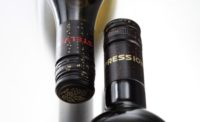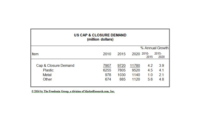New methodology for evaluating the relative creep performance of plastic caps and closures

Caps and closures is one of the largest and most complex packaging market segments. Plastic closures are widely used for containers and packages for beverages, foods, cosmetics, chemicals and pharmaceuticals. Closures protect the contents and seal the container to maintain shelf life and keep products secure from undesired opening. Such a wide range of applications requires many types of closures, such as screw top, tamper-evident, dispensing, hinge and snap-on.
Polypropylene and polyethylene are the two major polymers used for plastic caps and closures, which are manufactured through injection molding (IM) or continuous compression molding (CCM) processes. Depending on the end use, a plastic cap or closure may require a balance of characteristics, such as stiffness, toughness, deformation resistance, environmental stress cracking resistance (ESCR), taste and odor performance, seal performance, dimensional stability and torque removal (openability).
The deformation resistance of a plastic closure under different stresses, temperatures and times is one of the most important considerations. It can affect the bottle and closure performance characteristics such as seal integrity and handling on a high speed bottling line. Materials under constant stress may incur creep, the tendency of a solid material to move slowly or deform permanently under the influence of mechanical stresses. The creep properties of a plastic closure can affect the sealing performance of the plastic closure (especially linerless closures) on a bottle or a package.
Studying the creep deformation properties of plastic closures can be challenging due to their complex geometries and generally small dimensions. Test methods should be reflective of what the closure could experience during its lifetime. Closure deformation performance testing can be conducted using a variety of methods.
The industry standard ASTM test (D-2990) for creep testing, which typically uses lab-scale compression-molded plaques, may not reflect the real world material state and stress a cap or closure could experience. A second method is measuring torque during the closing and opening of a closure on a bottle over time. However, this technique is time consuming and slows the evaluation and commercialization of a new closure. Finite element analysis (FEA) provides another alternative means to predict deformation, typically using initial resin properties as inputs. This method requires specialty software, expertise and further validation. Given each of these existing evaluation method’s drawbacks, there is a need for a new, rapid method that accurately measures cap and closure creep deformation behavior.
To address the challenge in investigating the creep performance of a plastic closure, a new methodology has been developed using experimental tests and modeling approaches. Compressive deformation data of different closures with varying geometries, dimensions and weights were collected using a modified test probe in a rotational rheometer. The data were then used to develop deformation models. Creep characteristics of closures were then calculated using the models to compare their relative deformation performance. The creep data could be correlated to end-use closure performances such as seal integrity in a sealed bottle-closure system.
This methodology offers several benefits over older, common tests. It is quicker and more cost-effective for the comparison of creep resistance in closures, provides better reflection of the true polymer morphology effect of a closure - especially for polyethylene - and is easier to establish structure-property relationships for better closure or resin designs. With these benefits, this methodology has the potential to aid and accelerate closure design and commercialization by providing a rapid and cost-effective means for predicting resin performance, closure deformation, and ultimately the end-use performance of a sealed bottle and closure system. These insights in turn have the potential to lead to new packaging innovations and bring better-designed and better-performing products to market more quickly.
Looking for a reprint of this article?
From high-res PDFs to custom plaques, order your copy today!






